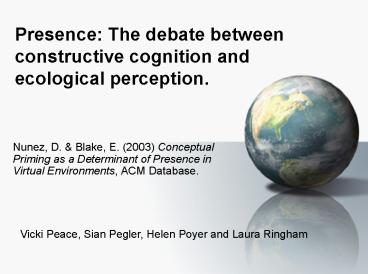Presence: The debate between constructive cognition and ecological perception. - PowerPoint PPT Presentation
Title:
Presence: The debate between constructive cognition and ecological perception.
Description:
... Scale of Slater, Usoh & Steed. Procedure: Instruction and training stage ... Slater, M., Usoh, M., Steed, A. (1994) Depth of Presence in Immersive Virtual ... – PowerPoint PPT presentation
Number of Views:75
Avg rating:3.0/5.0
Title: Presence: The debate between constructive cognition and ecological perception.
1
Presence The debate between constructive
cognition and ecological perception.
- Nunez, D. Blake, E. (2003) Conceptual Priming
as a Determinant of Presence in Virtual
Environments, ACM Database.
Vicki Peace, Sian Pegler, Helen Poyer and Laura
Ringham
2
Overview
- What is presence?
- How is presence explained?
- Ecological v Constructive Cognition
- Case Study
- Issues of measurement
- Conclusions and Questions
3
What is presence?
- Presence is the idea of being there
- the degree to which the virtual environment
dominates over the real environment as the
basis for thought - (Nunez and Blake, 2003)
4
Where is the controversy?
- In general, presence is a controversial area.
- Many debates
- What actually is presence?
- How can presence be measured/evaluated?
- Does presence have an influence on tasks?
- SELECTED DEBATE What is the basis of presence?
- Ecological v Constructive Cognition
5
Basis of Presence?Constructive v Ecological
- CONSTRUCTIVE COGNITION
- Eysenk Keane (1995)
- Higher level processing
- Top-Down
- Mental processing MOST important
- Perception and schemata
- Presence obtained as a process of mental
processes interacting with sensory information
- ECOLOGICAL PERCEPTION
- Gibson (1979)
- Direct Perception
- Bottom-Up
- Sensory info MOST important
- Affordances
- Presence due to individuals perception of sensory
information and action within their environment.
6
The Case Study 1
- Conceptual Priming as a Determinant of Presence
in Virtual Environment. - Nunez and Blake (2003)
- Aim to determine if presence is actually
constructed by the user or if it simply arises
from sensory stimulation only. - The study tested two hypotheses
- 1. If a user has active schemata which are
related to the VE which the user is
experiencing, then the user will experience more
presence - 2. If the VE is rendered on a higher
fidelity display system, the user will experience
more presence
7
The Case Study 2
- The experiment had a 2x2 factorial ANOVA design
- Stimulus quality of VE display system
- Conceptual priming
- Two levels were used for each variable
- The dependant variable was presence
- 55 undergraduate participants
- Each participant took part in two experiment
sessions, exploring two different VE and filling
in two sets of presence questionnaires.
8
Monastery VE
9
Hospital VE
Figure 4 Hospital VE ward room in low stimulus
quality
10
The Case Study 3
- Hardware
- Non-immersive, desktop-based systems
- Software
- VE exploration tool DAVE
- VEs
- Training environment
- Medieval European Monastery
- Hospital
- Priming
- Printed booklets either related to or not related
to the theme of the VE
11
The Case Study 4
- Measures
- Presence Questionnaire of Witmer Singer
- Presence Scale of Slater, Usoh Steed
- Procedure
- Instruction and training stage
- Priming stage
- Exploration stage
- Questionnaire stage
- Second iteration
12
Results
- Relevant Prime Hospital or Monastery
- High presence in high quality environment
- Lower presence in low quality environment.
- Irrelevant Prime Steam Trains
- Presence similar between quality
- Interaction of Priming and Stimulus Quality
- Priming mediated experience of presence
- In high quality context prime enhanced
presence. - In low quality context prime reduced presence.
13
Conclusions
- Mental state of user influences their experience
of presence. - But only in certain instances therefore
- Presence is not a scaled sum of sensory
components. - Presence is constructed through both sensory
inputs and users mental context. - Explained in terms of schemata activation
- Priming pre-allocates processing resources to
related perceptions. - In Irrelevant Condition processing of unrelated
perceptions is difficult schemata deactivation - In High Quality Condition enhanced processing
smooths over inconsistencies - In Low Quality Condition fit isnt good enough
for enhanced processing OR bad enough for
schemata deactivation poor processing
14
What does this add to the debate?
- Support for more recent constructive concepts of
perception (Eysenk Keane) over ecological
perception (Gibson) - Higher processes have a mediating role in the
experience of presence - Howeverboth views have explanatory power.
15
Critique
- Criticisms of study
- No measurement of stimulus quality or intensity
of priming provided - Measurement of presence based on pen and paper
questionnaires - Lack of an effective measure of presence
16
Measurement of Presence Other methods
- Objective Measures
- - Measurement of physiological and behavioural
responses - Qualitative or Ethnographic Approaches
- - In depth studies
- A Stochastic Model of Presence
- - Participants required to report whenever a
break in presence occurs while they are present
in the VE
17
References
- Eysenk, M.W. Keane, M.T. (1995) Cognitive
Psychology A Students Handbook. Hove Psychology
Press - Gibson, J.J. (1979) The Ecological Approach to
Perception, Houghton-Mifflin. Boston. - Nunez, D. Blake, E. (2001) Cognitive Presence
as a unified concept of virtual reality
effectiveness. Proceedings AFRIGRAPH 2001, p.
115-8 - Nunez, D. Blake, E. (2003) Conceptual Priming
as a Determinant of Presence in Virtual
Environments, ACM Database - Witmer, B.G and Singer, M.J. (1998) Measuring
Presence in Virtual Environments A Presence
Questionnaire, Presence Teleoperators and
Virtual Environments, 7(3), 225-240. - Slater, M., Usoh, M., Steed, A. (1994) Depth of
Presence in Immersive Virtual Environments,
Presence Teleoperators and Virtual Environments,
MIT Press 3(2), 130-144.































